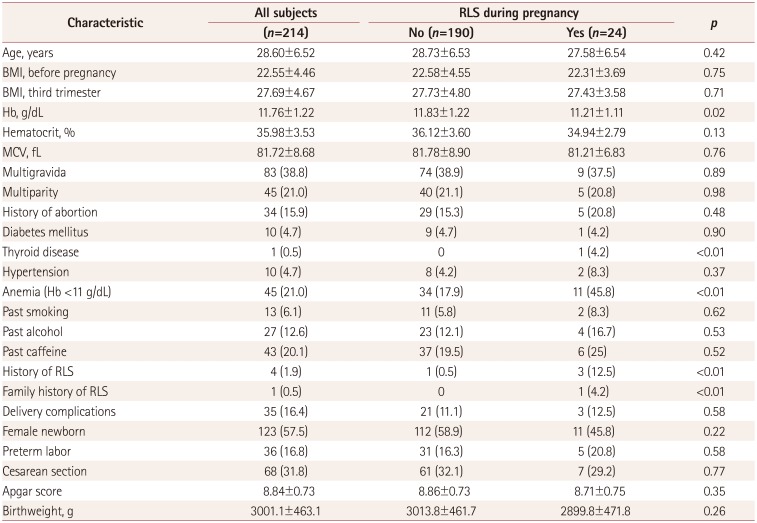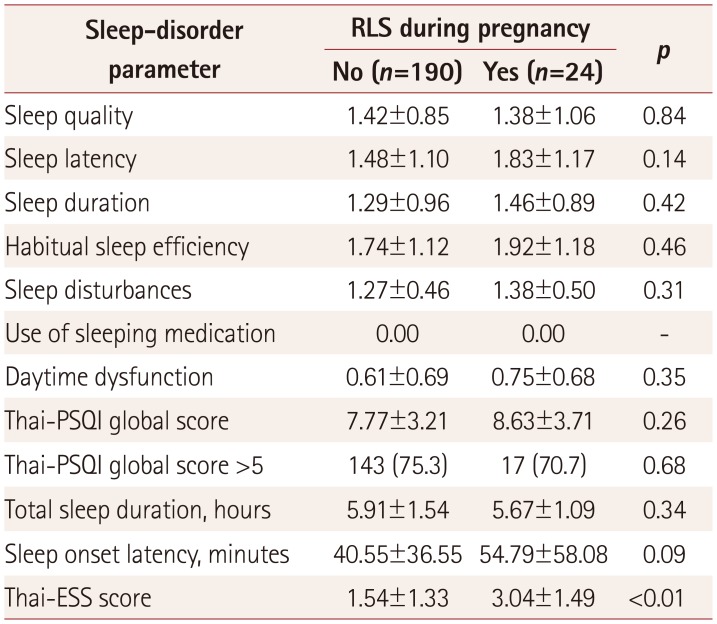1. Allen RP, Picchietti D, Hening WA, Trenkwalder C, Walters AS, Montplaisi J. Restless legs syndrome: diagnostic criteria, special considerations, and epidemiology. A report from the restless legs syndrome diagnosis and epidemiology workshop at the National Institutes of Health. Sleep Med. 2003; 4:101–119. PMID:
14592341.
2. Ekbom KA. Restless legs. Acta Med Scand. 1945; 158(Suppl):4–122.
3. Walters AS. Toward a better definition of the restless legs syndrome. The international restless legs syndrome study group. Mov Disord. 1995; 10:634–642. PMID:
8552117.
4. Srivanitchapoom P, Pandey S, Hallett M. Restless legs syndrome and pregnancy: a review. Parkinsonism Relat Disord. 2014; 20:716–722. PMID:
24768121.

5. Ghanei Gheshlagh R, Lanjavani T, Lazari N, Moslemi B. Comparison of the quality of life in pregnant women with and without restless legs syndrome. J Clin Nurs Midwifery. 2014; 3:54–61.
6. Li LH, Chen HB, Zhang LP, Wang ZW, Wang CP. A community-based investigation on restless legs syndrome in a town in China. Sleep Med. 2012; 13:342–345. PMID:
22172960.

7. Manconi M, Govoni V, De Vito A, Economou NT, Cesnik E, Casetta I, et al. Restless legs syndrome and pregnancy. Neurology. 2004; 63:1065–1069. PMID:
15452299.

8. Neau JP, Marion P, Mathis S, Julian A, Godeneche G, Larrieu D, et al. Restless legs syndrome and pregnancy: follow-up of pregnant women before and after delivery. Eur Neurol. 2010; 64:361–366. PMID:
21088424.

9. Shang X, Yang J, Guo Y, Ma S, Jia Z, Xue R. Restless legs syndrome among pregnant women in China: prevalence and risk factors. Sleep Breath. 2015; 19:1093–1099. PMID:
25450154.

10. Sikandar R, Khealani BA, Wasay M. Predictors of restless legs syndrome in pregnancy: a hospital based cross sectional survey from Pakistan. Sleep Med. 2009; 10:676–678. PMID:
19110469.

11. Suzuki K, Ohida T, Sone T, Takemura S, Yokoyama E, Miyake T, et al. The prevalence of restless legs syndrome among pregnant women in Japan and the relationship between restless legs syndrome and sleep problems. Sleep. 2003; 26:673–677. PMID:
14572119.

12. Uglane MT, Westad S, Backe B. Restless legs syndrome in pregnancy is a frequent disorder with a good prognosis. Acta Obstet Gynecol Scand. 2011; 90:1046–1048. PMID:
21504414.

13. Chen SJ, Shi L, Bao YP, Sun YK, Lin X, Que JY, et al. Prevalence of restless legs syndrome during pregnancy: a systematic review and meta-analysis. Sleep Med Rev. 2018; 40:43–54. PMID:
29169861.

14. Chang JJ, Pien GW, Duntley SP, Macones GA. Sleep deprivation during pregnancy and maternal and fetal outcomes: is there a relationship? Sleep Med Rev. 2010; 14:107–114. PMID:
19625199.

15. Sitasuwan T, Bussaratid S, Ruttanaumpawan P, Chotinaiwattarakul W. Reliability and validity of the Thai version of the Pittsburgh sleep quality index. J Med Assoc Thai. 2014; 97(Suppl 3):S57–S67.
16. Walters AS, LeBrocq C, Dhar A, Hening W, Rosen R, Allen RP, et al. Validation of the international restless legs syndrome study group rating scale for restless legs syndrome. Sleep Med. 2003; 4:121–132. PMID:
14592342.
17. Liu G, Li L, Zhang J, Xue R, Zhao X, Zhu K, et al. Restless legs syndrome and pregnancy or delivery complications in China: a representative survey. Sleep Med. 2016; 17:158–162. PMID:
26847992.









 PDF
PDF ePub
ePub Citation
Citation Print
Print


 XML Download
XML Download